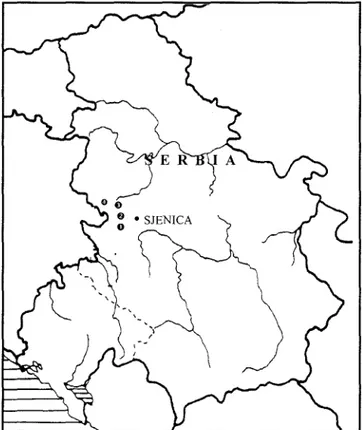Arch. Biol.Sci.,Belgrade, 56 (1-2), IIP-12P, 2004.
NEW RECORDS FOR THE BRYOPHYTE FLORA OF SERBIA. M. Veljic, P. D. Marin,
B.
Petkovic,
and
B.
Ljubic,
Institute of Botany and "Jevremovac" Botanical Garden, Faculty of Biology, University of Belgrade,
11000
Belgrade, Serbia and Montenegro
UDe 582.32(497.11)
Bryoflora of Serbia has been the subject of an intensive survey during the last ten years. According to some recent check lists and other papers (Sab o v lj e vic & Stevanovic. 1999; Ve Ijic etal., 2001a, 200lb), 422 species of genuine mosses and 82 species of liverworts (Sab o v lj evic. 2000; Ve ljic et al.,200la, 200lb) are known for this territory.
During the last several years attention has been focused on the Carpatho-Balkan Mountains (Dubasnica River, August 1997) in the eastern part and Stari Vlah and Raska (August 1999-May 2000) in the southwest part of Serbia.
The collected material is deposited in the herbarium of the Institute of Botany and "Jevremovac" Botanical Garden, Faculty of Biology, University of Belgrade (Vof. B).
Within the surveyed area, one hepatic and three genuine mosses were recorded for the first time in Serbia.
Given after name of each species is the locality were it was recorded, together with the locality number (indicated on the map in Fig. 1), altitude, geological and pedological base, collecting time, and vegetation.
The nomenclature used is in accordance with Corley et al.,(1981) and Grolle (1983).
Marchantiopsida (Hepaticae)
Lophoziacollaris(Nees) Dum.
This species was recorded at locality 1, which is situated in the village of Caricina southeast of Sjenica at an altitude of 1,300 m a.s.l. The geological base is serpentine coated with diluvium. The ground consist of black and brownized black soil on serpentine. Vegetation is aCariceto-Eriophoretumand Oxali-Alnetum incanaeassociation. Sampling was performed in May 2000.
Bryopsida (Musci)
Hymenostylium recurvirostrum(Hedw.) Dix.
The given species was found at locality 2, which is 600 m upstream from the village ofPralja west ofSjenica at an altitude of 1,130 m a.s.l. The geological base is serpentine. The ground consist of black and brownized black soil, and vegetation is ex-tremely degraded. The sample was taken in August 1999.
Pseudocrossidium revolutum(Brid.) Zander
This species was present at locality 3, which is on the right side of the head of Radoinja Lake near Kokin Brod (810
lIP
In a.s.l.). The geological base is calcareous. The soil is poor, skeleton-rock. Vegetation is a rock association. The sample was taken in May 2000.
Gyroweisiatenuis (Hedw.) Schimp.
With this species and a number of well-known species common for this region, locality 4 is situated near the Uvac Monastery northeast of the town of Priboj on the Lim River at an altitude of 510 m a.s.l. The geological base is serpentine. Ground consists of the black and brownized black soil. Vascular plant vegetation is composed ofSalicetum albaeandQuercetum montanum.Sampling was performed in May 2000.
Acknowedgement- The authors are grateful to the Ministry of Science, Technology and Development of the Republic of Serbiafor fi-nancial support (GrantNo 1544).
12P
References. Corley, M.F.Y., Crundwell, A.c.. Duel, R., Hill, M.O., Smith, A.lE. (1981). Mosses of Europe and the Azores; an annotated list of species, with synonyms from the recent literature. Journal
0/
Bryology11: 609-689. - Grolle, R. (1983). Hepatics of Europe including the Azores: an annotated list of species with synonyms from the recent literature. Journal of Bryology12:403-459. - Sabovljevic, M. (2000).
Checklist ofhepatics of the Federal Republic of Yugoslavia.Lindbe.gia
